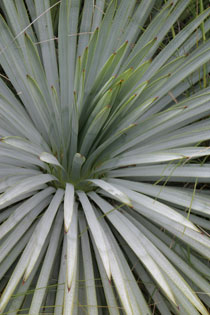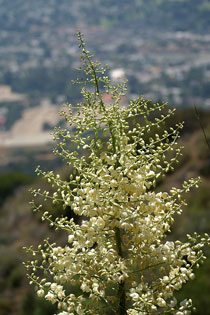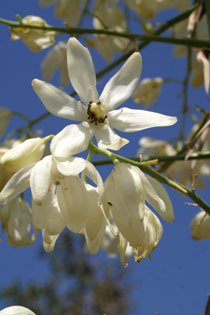Plant of the Month: Chaparral Yucca
Text and photos by Gabi McLean
(reprinted with permission from the Paw Prints, July 2022, Eaton Canyon Nature Center Associates)
|
Chaparral Yucca, Whipple Yucca, Our Lord’s Candle This spectacular monocot flowers in April, May, and June, when hundreds of creamy-white flowers adorn the treelike inflorescence. Chaparral Yucca can be spotted in Eaton Canyon, the San Gabriel Mountains, and in Southern California and Baja California, except in the deserts, up to 7500 feet in elevation. Even when not in flower, this shrub distinguishes itself from other shrubs in that it does not have woody branches typical for most shrubs. Instead, it has tough gray-green leaves, that grow in a rosette and, over the years, form a huge spiky ball. The very narrow and fibrous leaves can reach a length of five feet and end in a hard brown needlelike tip. The strong fibrous strands in the leaves make it almost impossible to trim the spikes off to disarm the plant. It demands respect and, with its sharp spikes, defends its space very effectively. 
The life cycle of Chaparral Yucca is quite unusual because it will flower only once, after having grown for several seasons before it is able to produce the spectacular flower stalk with its numerous, fragrant flowers. In its final season, the plant sends up a flower stalk that first resembles a giant red asparagus. This stalk grows several inches per day, and in two weeks can reach its full height, usually 10 to 14 feet. Within days, this “asparagus” develops a tree-like structure with many branchlets that support hundreds of two-inch-wide flowers. The fragrant, creamy-white flowers have three sepals and three petals that look so much alike that the casual observer will count them as six petals. Six fleshy stamens encircle the three-parted style and head-like stigma. 
|

For the flowers to produce fruit, the plant must be pollinated by the yucca moth that has a symbiotic relationship with the Chaparral Yucca. The moth cannot reproduce without the yucca, and the yucca cannot reproduce without the yucca moth. It flies at night and therefore is seldom seen. Once the yucca is pollinated and fertilized, it produces 2-inch-long, 3-parted capsules that contain six columns of neatly stacked black, discshaped seeds, the size of your pinky fingernail, and so light you might not feel it in your hand. After the flowers have produced the fruits, the whole plant will die. The leaves turn brown and fold over and the flower stalk turns gray, the fruit capsules pop open while still on the inflorescence and spill the seeds on the ground where they get blown by the wind or washed away with the next torrential rain. The dry flower stalk may remain standing for a couple of seasons and serve as shelter for cavity nesting birds. This plant has been much appreciated and well used by indigenous peoples in most of southern California. The roots make a nice soap when mixed with a little water and rubbed together. The young new flower stalk can be eaten after it has been cooked for many hours—from one to three days—in an earthen oven. The oven is constructed in the ground, lined with hot rocks, and covered with more hot rocks, soil, and leaves. The flowers can also be eaten, raw or sauteed. The fiber strands in the leaves require proper preparation before they are used for making a variety of ropes, as well as constructing sandals. The ropes are extremely strong and well suited to construct tools, to tie branches together to serve as place of shelter, and to tie wooden planks together when building canoes. The canoes have been sturdy enough for ocean fishing and traveling to Catalina Island. Fibers still attached to the needle-like tip were also used to sow and mend clothing. This attractive plant is drought resistant and tolerates clay soil with good drainage. It is also fire resistant and can resprout after a fire. When entering a burned area just a few weeks or months after a fire, you will notice the pineapple-like blackened short, stout stems dotting the hillsides, with a few green leaves crowning the naked plants. My best memory of this glorious plant has been when hiking on Memorial Day weekend across the San Gabriel Mountains and seeing them in canyon after canyon, from Chantry to Devil’s Punchbowl. To me, Chaparral Yucca’s resilience and versatility are symbols of hope and recovery, and I look forward to its captivating beauty every spring. |
Keywords: Gabi McLean, Cliff McLean, Gabriele McLean, Clifford McLean, Nature at Hand, Gabi Horn, Gabriele Horn, Plants of the San Gabriel Mountains: Foothills and Canyon, Interpretive Guide on CD, Plants of the San Gabriel Foothills and Canyons, California native plants, Pasadena, Los Angeles, Los Angeles County, San Gabriel Valley, Southern California, Covina, natural, nature photography, photograph, environmental education, naturalist, docent, hike, hiking, CD-ROM, California native garden, gardening, flowers, wildflowers, San Gabriel Mountains, Angeles National Forest, California Native Plant Society, CNPS, Eaton Canyon Nature Center Associates, ECNCA, Arroyo Seco, invasive weeds, invasive plants, Chaparral Yucca, Our Lord's Candle, Hesperoyucca whipplei